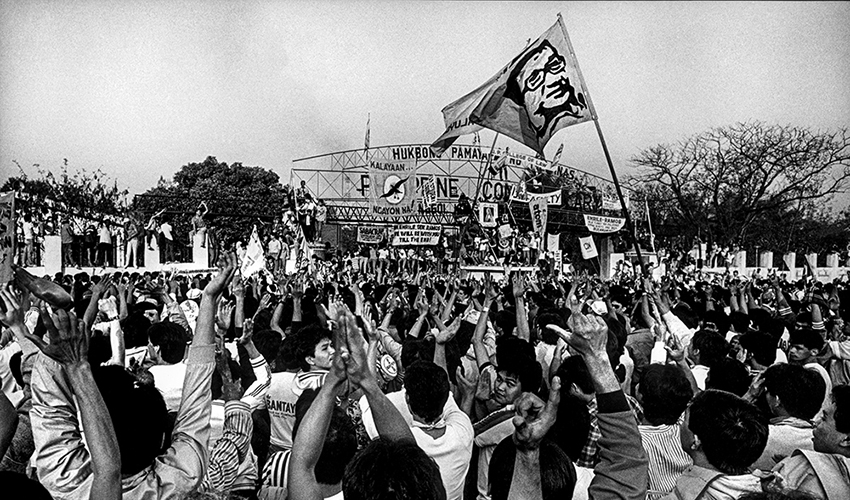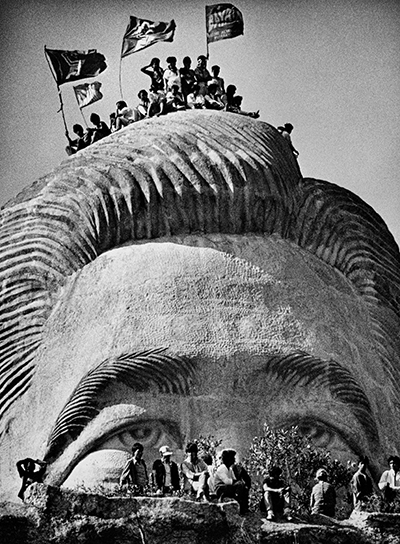Professor revisits Philippine revolution through Pulitzer Prize-winning photos

Thousands of supporters gather in a human barricade that repeatedly turns away Marcos tanks and troops and protects the pro-Aquino troops and leaders inside. A flag bearing the likeness of assassinated Filipino political leader Benigno Aquino Jr. waves over the crowd. Photo credit: Kim Komenich for The San Francisco Examiner ©2011/The Pictorial Collection, Bancroft Library, University of California, Berkeley.
When Kim Komenich, assistant professor of journalism at San Francisco State University, reflects on the Philippine Revolution of 1986, he notes, "It only took a few days, but it was years in the making."
For two of those years, Komenich was on assignment for The San Francisco Examiner, documenting on camera the events leading up to and including the civilian and military coup that toppled dictator Ferdinand Marcos on Feb. 25, 1986. The images tell the story of the revolution as it unfolds — Catholic nuns, rosaries in hand, form the first line of defense against machine-gun wielding Marcos troops. Smiling Aquino supporters band together as they burn a Marcos T-shirt. Aquino troops, crouching with machine guns poised, begin the takeover of the government-run television compound.
His coverage of what became known as the EDSA People Power Revolution earned him the 1987 Pulitzer Prize in spot news photography.
As the 30th anniversary of the revolution approaches, the Philippine Consulate in San Francisco will celebrate the event with a variety of activities, including an exhibit of Komenich's Pulitzer-winning portfolio and a "then and now" portrait series that features more recent images of subjects he initially made images of in the 1980s.

A large bust of Ferdinand Marcos carved into a hillside in Benguet is overtaken by demonstrators. Photo credit: Kim Komenich for The San Francisco Examiner © 2011/ The Pictorial Collection, Bancroft Library, University of California, Berkeley.
Komenich was in the field with Phil Bronstein, then a San Francisco Examiner reporter who later became executive editor and also received a Pulitzer nomination for his coverage of the revolution. "We focused on the excesses and corruption of the Marcos regime," Komenich said. "It was a wild time. One day we would spend with the communist New People's Army, and the next night we'd be having dinner with Imelda Marcos."
Komenich captured on film the last speech Ferdinand Marcos gave in the Philippines and the swearing-in ceremony of new president Corazon Aquino, both powerful images in his 14-photo, Pulitzer-winning portfolio.
Through the years, Komenich continued his photojournalism career at The San Francisco Chronicle and added teaching to his repertoire. Eventually, Komenich felt the need to refresh the work he had created during the revolution. "There came a point when the news photo became the historical photo, and I knew I had to return to the Philippines," he said.
In 2010, Komenich returned and, through social media and word of mouth, reconnected with many of the people he had photographed decades earlier.
He located one subject, originally photographed while working in a sugar field when she was 10 years old, through what he called "geophoto" tracking. "I literally held an 8-by-10 photo of a field with the mountains as a backdrop out the window of the car and waited until the outlines of the mountains in the distance lined up with the photo."
Komenich pulled over and asked someone in the adjacent field if his photo subject still lived there. The answer? Yes. His 2011 photo shows 36-year-old Riza Casarmel standing in the same field, the familiar mountains in the background, holding her ninth child.
The exhibit of Komenich's work opens at 6 p.m., Thursday, Feb. 25, at the Kalayaan Hall of the Philippine Center, 447 Sutter Street. Reservations can be made via email.
"I have some pictures that will be of value to future generations," Komenich said. He added, "To watch somebody's face as they look at a picture I took of them nearly 30 years ago and see the look of recognition — that's the joy in this business."